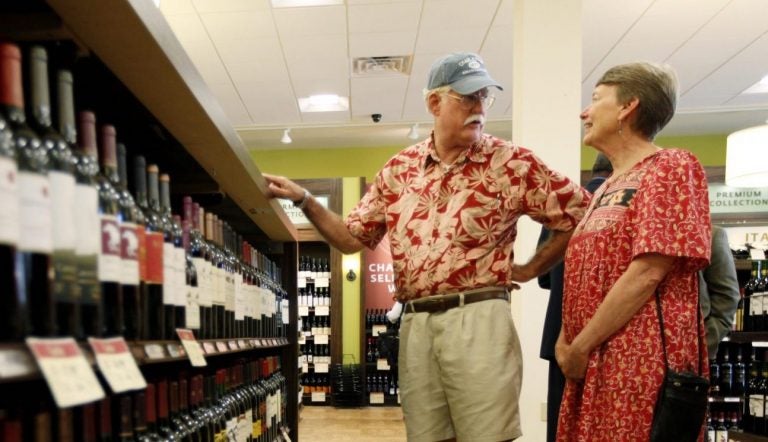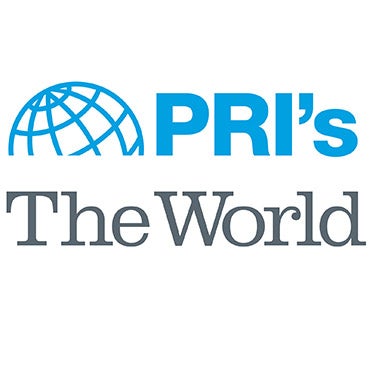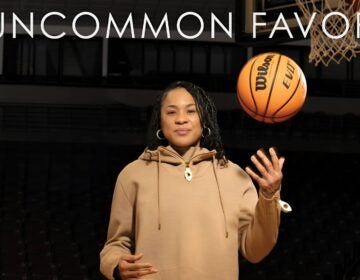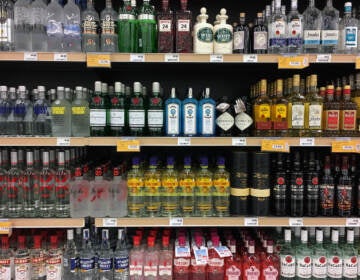Some hoped letting groceries, mini-marts sell wine would kill Pa.’s state stores. It hasn’t
Total sales at the state liquor stores, at $1.872 billion for 2018-19, are up 3.1% since Gov. Wolf and Speaker Mike Turzai famously toasted the wine privatization in 2016.

In this Thursday, July 22, 2010 photo, Hugh and Karen Hoffman of Wycombe, Pa. shop a newly opened state wine and liquor store in New Hope, Pa. (Matt Rourke / AP)
This story originally appeared on PA Post.
When Pennsylvania loosened the rules on alcohol sales in 2016, it marked an uneasy truce between those who wanted full liquor privatization, and those wanting to preserve as much as possible of the status quo.
The privatizers — who resented the state’s involvement in a retail business — felt they’d won some key customer convenience changes, including the sale of wine at private retailers, that would, over time, bleed the old state store system to the point where policymakers could finally agree to kill it once and for all.
Though there was no date certain for a closure of any of the 600 state-owned liquor stores built into the changes, their hope was they would fade into irrelevance.
Public sector unions opposed the reforms for the exact same reasons, arguing privatization of wine, the state stores’ top-selling product, was a nicked artery that would eventually kill off thousands of decent state jobs with the promise of good retirement benefits, all to give corporations a way to make more money.
“This privatization proposal will begin draining dollars from the state immediately, and by reducing foot traffic in the Wine & Spirits stores, weaken this asset,” Wendell Young IV, the president of United Food and Commercial Workers Local 1776, which represents about 3,500 state store employees, warned back in 2016.
His legislative allies, meanwhile, won some modernization tools for the state-owned stores — expanded hours of operation, more Sunday openings, greater flexibility in setting prices — that they hoped would help them stay afloat in the new order.
Instead, three years into this brave new liquor world, the system seems to have hit a new equilibrium.
Predictably, retail wine sales are down at the Pennsylvania Liquor Control Board’s “Fine Wine and Good Spirits” stores; the drop through 2018-19 is 6% since 2015-16, the last full fiscal year before the changes took effect. But, that drop has been more than offset by a surge of consumer interest in other liquors – which the state still holds a monopoly on – sales of which have increased 11% over the same time frame.
Add it up, and total retail sales at the state liquor stores, at $1.872 billion for 2018-19, are up 3.1% since Gov. Tom Wolf and state House Speaker Mike Turzai famously toasted the wine privatization in 2016. In-store sales are up an additional 1.9% for the current fiscal year (through January), according to PLCB data.
There are two ways to look at that — and trust us, at the state Capitol you get both views.
In a light most favorable to the PLCB and its retail clerks, it’s a minor miracle the system not only held its own but grew at a time when wine is now available at more than 1,000 other outlets. Wine enthusiasts can even have cases shipped from wineries direct to their doors.
Or, this could be seen as paltry growth at a time when the state stores are able to operate for longer hours and open on Sundays. And mass merchandisers like Walmart and Target haven’t even really joined the fray.
The larger debate over liquor privatization isn’t going to end anytime soon. But first, here’s a look at how the state stores have stayed relevant so far.
Competing for their lives.
It’s probably worth remembering that when they were created in the 1930s, Pennsylvania’s liquor stores were designed to make it pretty hard for Pennsylvanians to buy booze. With some of the Prohibition Era handcuffs finally unlocked in Act 39, the agency has worked hard to build on its strengths: specialization and the expertise that can spin out of that; and buying power.
“What you’re looking for at your neighborhood supermarket or your neighborhood convenience store is a very different experience than the product variety and depth that we have at Fine Wine and Good Spirits,” said PLCB Communications Director Elizabeth Brassell, using the brand flag that now flies over the state’s stores.
“Secondly… we are now one of the only places where you can go and you can talk to a wine specialist in every one of our premium collection stores and they’re going to tell you a wealth of knowledge about products and pairings and regions and all of the things that, again, you can’t find at a grocery store or a convenience store.”
PLCB Executive Director Charlie Mooney said an ongoing, system-wide refurbishing of the stores has also proved popular. “They’re inviting. They’re bright. They’re located correctly. We have half the stores completed, and we have an accelerated schedule to go ahead and refresh and rebrand the remaining stores in the next 18 months.”
Five “taste-and-learn” centers around the state enable interested customers to get baseline instruction in and appreciation for the various types of beverages on the shelves – just like local kitchen shops that for years have offered their patrons in-shop cooking classes.
“We’d like to get another half-dozen open this year, and continue and see where it takes us from there,” Mooney said.
And the executive director believes his retail directors are doing a better job of anticipating changes in the marketplace.
“You’re going to see this spring, just a proliferation of cans,” Mooney said. “Everybody wants a can these days, or a smaller package — It’s an opportunity for the younger demographics to come in and say: ‘Yeah I’d like to try that,’ and instead of paying fifty dollars for an item they’re paying twenty-three.”
Next up?
Just like some of the state’s major grocery chains, PLCB is in negotiations to launch a same-day delivery service later this year. As Mooney roughed out the concept, “You order on-line by 10 a.m., you get guaranteed delivery by 2 p.m.; you order by 1 p.m., you get it by 6 p.m. at your door. All with real-time inventory in the store of your choice.”
Some time after that, imagine e-receipts opening the door to direct-to-consumer marketing and Fine Wine and Good Spirits loyalty cards.
“From a perception standpoint, we’re not the government anymore,” Brassell said. “We have come to meet the customers where they’re at, deliver the experience they’re looking for, deliver the selection that they’re looking for. So from a public standpoint, we’re not getting complaints anymore. We’re getting kudos.”
There are still some important considerations that could change the current retail booze balance:
1. Has the state system already taken its hardest punch? Or is the private sector side still growing?
Yes, Mooney says. And yes.
There are still hundreds of idle “restaurant” licenses that could be auctioned to new owners in the coming years, setting the stage for more wine-to-go retailers.
But Mooney thinks PLCB has passed its biggest test. After zooming from zero to 826 grocery and convenience store permittees in the last three years, he expects the number of new groceries getting wine-to-go permits will fall back to single-digit growth rates in the next year or two; convenience stores, Mooney believes, will get there another year or two after that.
“There’s a finite number of stores out there that are qualified for WEPs (they need a restaurant area with seating for at least 30, offer on-premise consumption and have separate checkout lanes, among other requirements). We’re coming down to the smaller grocery stores, the independent grocery stores,” the executive director said.
“All the Giants are selling wine. All the Wegmans. All the Giant Eagles, the Acmes, the Weis Markets…. Most of the major grocery stores are in. So I think the novelty of the entry into the marketplace is over.”
2. The big-box challenge.
One big caveat to the above.
Walmart has one operating liquor license in Pennsylvania so far; it started selling booze from an old McDonald’s room at a store in Uniontown last year. The chain has five more applications pending, and a lot more are expected. That may be the next big threat to the PLCB market share. “Walmart has told us they want to expand from western Pennsylvania east, and stay in the rural areas first. That’s their strategy,” Mooney said.
(Target also has one active wine-to-go permit; it has no other applications in the pipeline to date.)
Mooney thinks, base on the kinds of products Walmart is offering in Uniontown, Walmart’s larger play will ultimately be more of a threat to the other grocers and convenience stores in the market.
“We’re not that worried about it,” he said. “That’s a different experience They’re going to sell the type of wine that their customers are looking for.”
3. Pressure from distillers.
Sellers of distilled spirits are starting to complain about market imbalance, now that 1,500 locations can sell wine, while their products are still confined to the 600 or so state stores.
Yes, spirits sales have gone up at the state stores in recent years, part of a national surge. But the number of retail outlets in Pennsylvania selling hard liquor is stuck at .66 per 10,000 residents; nationally, that ratio averages to about 2 stores per 10,000.
“It’s time to fix that imbalance,” said David Wojnar, vice president of state government relations for the Distilled Spirits Council of the United States, or DISCUS. The trade association has thrown its weight behind bills that would open the door to liquor sales in groceries and/or beer distributors, arguing the way things are now, they’re running up against real limits to growing their markets.
But a proposal to let Pennsylvania’s beer distributors sell booze suffered an early setback this month when beer distributors’ trade associations came out against it. They cited worries that such a reform would increase calls for another change that they oppose more than they want product line expansion — the ability for convenience stores and groceries to sell more than two six-packs of beer in a single transaction.
“They’d rather do nothing,” said the bill’s sponsor, Sen. Pat Stefano, of Fayette County. Stefano is chair of the Senate Law and Justice Committee, where all the liquor bills start in the state Senate.
Stefano said he has decided to park that issue for the time being, but he is open to other reforms, such as ending requirements that wine and beer be sold from a specific cash register.
Ongoing support for privatization.
Many in the Republican-controlled Legislature argue the 2016 reforms must only be a way station; a brief layover on the ultimate journey to full privatization.
“It’s clear that the private sector responsibly handles the sale of wine and beer in their stores, and it’s clear that the public loves that they can buy wine and beer in these stores,” said Turzai, R-Allegheny County, the biggest champion of full privatization in the Legislature in this generation.
“We do not need state stores.”
But measured against current political and economic realities, that bigger debate is probably on ice for the short term.
Wolf, a Democrat with strong loyalties to the state’s public-sector unions and whose second term runs into January 2023, agreed to the wine privatization plan in 2016 as part of larger budget talks, but he has signaled he has no interest in further changes at this time.
“These reforms have been popular but are still new,” Wolf’s press secretary J.J. Abbott said last week. “Governor Wolf believes at this time that we should take more time to see how Act 39 is implemented long term before adding more complicated changes to the system. He does not support privatization.”
More surprisingly, some other key Republican lawmakers who are philosophically bent toward privatization say they are impressed enough with the recent results to let the present system stand for the near-term.
“I don’t have any desire to dismantle the state store system,” said Stefano, guessing at one point that any dramatic changes to the system may be another 10 to 15 years away. “They’re doing all the right things… and we’ve got 5,000 Pennsylvanians that work in that system.”
With the improvements to wine and beer accessibility in place, Stefano believes, political pressure for full privatization has waned.
It doesn’t hurt that the system continues to make big money for the state.
Remember, in Pennsylvania’s model, the PLCB is also the wholesaler for all wine and liquor being sold at retail. Because it is now selling product direct to those groceries, bars and restaurants , its sales to licensees have grown even faster. Sales to the licensees are up 35.7 percent from 2016 to 2019.
Wine sales to licensees have nearly doubled, from $141.4 million in 2016, to $278.9 last year.
In all, the PLCB generated about $750 million for the state last year, including $381.9 million in liquor taxes, $185.1 million in profits, and $150.2 million in sales tax.
So, from a revenue standpoint, the new balance seems to be working well for state government.
For the general consumer? Let’s just say the conversation continues.
PennLive did hear from shoppers this week who said they like the added convenience ushered in by the 2016 reforms, and felt the law struck a good balance between convenience and control.
Wally, a 57-year-old Lower Paxton Township resident, walked out of an area Weis Market one night this winter with groceries and a 12-pack of beer in his cart. With a wintry drizzle falling around him, he was happy with the one-stop convenience. But he also said he didn’t really see a need for further expansion of outlets to buy alcohol.
“I’m happy where it’s at,” he said.
But we also encountered folks like Carlisle resident John Lyter, who remains frustrated that the same bottle of wine he and his wife favor routinely costs about three to four dollars more than they can find it in a grocery during trips to Williamsburg, Va.
Lyter said he can’t help but feeling a little held-up every time he visits a state store.
“I’m a price shopper, so I think it’s be a better situation for the customer if you had all sorts of merchants competing for your business,” he said. “I think the LCB just holds the Pennsylvania citizens hostage.”
WHYY is your source for fact-based, in-depth journalism and information. As a nonprofit organization, we rely on financial support from readers like you. Please give today.




